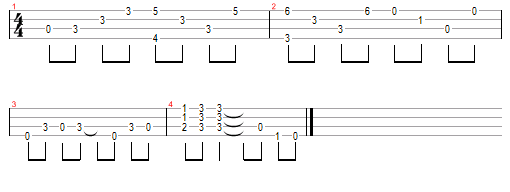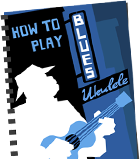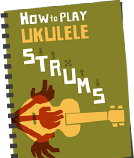MJ Hibbett – A Million Ukeleles (MP3)
MJ Hibbett – I Did A Gig In New York (MP3) via MySpace
MJ Hibbett has spent most of his musical life knocking out Billy Bragg/Half Man Half Biscuit type punky numbers on mundane aspects of English life (particularly football and antiquated digital technologies) with his band The Validators. But he’s gone solo and picked up the uke for his most recent album A Million Ukeleles (sic). The album comes complete with ukulele chords for all the songs which you can download here.
Mark was kind enough to answer a few of my questions.
Q: How long have you been playing the uke and what made you take it up?
It’s been nearly two years now, as I got my first one as a birthday present. I’ve always liked the idea of them, probably due to a season of George Formby films that were on one year during the school holidays, which me and my brother lapped up when we stayed with various Nans! I also read an article online which gave some brilliant advice for playing uke – if you can’t play a chord, play an easier one, and if you can’t play an easier chord just stop playing and sing louder. That’s how i play the guitar anyway, so I thought the uke might be the instrument I was meant to play all along!
Q:What made you decide to make a solo album? How’s it different from the Validators stuff?
I always write a lot more songs that we manage to record with The Vlads, partly because we’ve all got proper grown-up lives these days and don’t have as much time as we’d like to get together to do stuff, and partly because they don’t like some songs as much as others! We were talking about this in the pub after a practice one night, and as I’d been doing some demoes in a proper studio (just round the corner from my work) Tim, our drummer, suggested that I put them out as a solo album. I think he meant it as a way of stopping me nagging them to play certain songs! I leapt on the idea, but rather than release those demoes I used it as an excuse to buy myself a new four-track!
The title track of A Million Ukeleles is the triumphant story of a teacher who sets fire to the school’s recorder collection, replaces them with ukes and sets off a country wide ukulele obsession.
Q. What’s the story behind the song A Million Ukeleles?
The idea to write it came from reading a succession of articles about how easy and fun it is for children to play the uke, combined with my own experience of playing it and loving it. The actual content, though, comes from years and years of me getting wound up about Traditional Music Teaching. When i was at school music lessons seemed to be more about dissuading kids from music – we playing boring songs on recorders and glockenspiels that made a horrible dreary noise, were forced to learn music theory and classical instruments, and if anybody stuck with it they were made to play the violin, a ludicrously difficult and unpleasant sounding instrument for a child to try and
play!Because of that it was years and years before i discovered that, actually, making music is a piece of piss and doesn’t require a classical education. It’s EASY to make music, and the easier it is the more fun it is, and it struck me that all the difficult language, the over-valuation of technical virtuosity and sneering and rudimentary players is designed to stop people from having any fun, and keep the joy of music contained within a small elite. I know this is hardly an original observation, every ten years ago punks or rockers or whoever come out with it again, but when I started playing the ukelele and discovered how much fun it is, and also how much “serious” musicians sneer at it, it struck me that the humble uke is an ideal symbol of the power of fun, easy music making.
The song most associated with MJ Hibbett and the Validators is probably Fair Play Trophy. A song regularly updated to document the travails of the England football team in major tournaments. For those of you sensible enough to follow such happenings, England failed to qualify for this year’s World Cup.
Q: Does the lack of English involvement in the World Cup mean no new versions of Fair Play Trophy this year?
For me, that’s the only good thing about it! I’ve re-written that song about eight times now, for various championships, and to be honest I’m heartily sick of it, so when we failed to qualify I was one of the few people in the country who were actually relieved!!
Q: Can we expect to hear more ukulele stuff from you in future?
Very much so, yes. In the past The Validators have been a bit wary of
ukelele songs, but recently Tim and Emma’s daughters discovered them,
and this weekend Frankie, our bass player, bought one of those Flying
V ukes, so we may have a full set of converts one day! There’s also
some ukelele on the new band album which we’re recording at the
moment, and in February I wrote a whole album’s worth of songs for
February Album Writing Month (FAWM.org), many of which were PACKED
with ukeleles!
A Million Ukeleles is available (in a more hi-fi version than those above) from the evil iTunes and the saintly eMusic. You can buy a Million Ukeleles t-shirt on his website. And you can buy the latest single from MJ Hibbett and Validators, Do The Indie Kid here.







